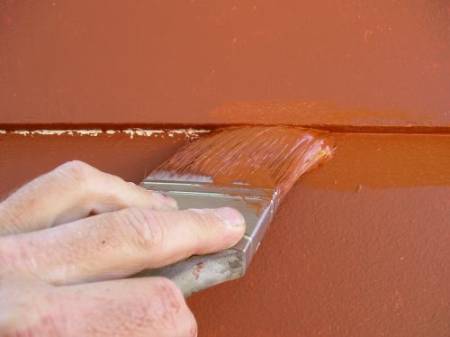The most basic house painting method is brushing and rolling exterior paint. Although more labor intensive than spraying, this paint application method can produce superior results in some instances.
This painting technique is best suited for low houses, 1—1-1/2 stories. Any painted building material can be rolled. This includes wood or masonite siding, soffits and stucco. The list can be extensive, but generally siding and soffits are the most common materials.
Properly prepare all surfaces before beginning any exterior paint application. This includes pressure washing, removing all loose paint, priming bare areas and caulking, plus masking and covering windows, doors and sidewalks.
Painting Tools Needed For Rolling Exterior Paint
The basic tools are the same kinds of roller covers, frames and roller extension poles that are used on any interior painting, with a few considerations.
Use a lamb’s wool cover for the easiest and best results. The best universal roller cover nap thickness is 3/4 inch, for most lap siding applications. 1 inch or thicker should be used on stucco and concrete block. True locking roller frames and heavy-duty roller extension poles will reduce physical fatigue and frustration.
The best paint brushes to use depends on the type of paint, but always use professional grade paint brushes for the best results. Generally, 2-1/2 and 3 inch brushes will be the best sizes to use. You have a choice of angled or flat bristles. The best for you depends on your own preferences. I like the flat sash brushes.
Considerations for Rolling Exterior Paint
- Work in the shade when possible. This will make the experience more enjoyable and keep the paint from drying to fast.
- Apply two coats for the best look and protection. Modern acrylic paints need to be applied thickly and two coats will give you the proper thickness.
- Brush or cut-in the high areas first. These are the areas that require the use of an extension ladder. This way you won’t have to lean the ladder against fresh paint. Cut-in areas include the soffit to wall, behind the fascia board to the soffit, around windows and doors plus around any vents. The entire house can be cut-in first, before each coat, if a light color is used. I find it easier to concentrate on one side at a time.
- Draw out the brushed paint 3-4 inches. This allows you to paint at a faster pace without worrying about bumping into non-painted items.
- After the first coat is applied take a close look at the siding edge, were the two pieces of siding overlap. This edge needs to be fully sealed with paint and is difficult to do with a paint roller, even a thick one. Apply paint as needed to the siding lip with a brush.
Rolling Exterior Paint
Read the manufactures application instructions before starting any painting. Any special considerations will be on the product label.
Begin rolling the exterior paint from the top down, with the soffits first. Roll the soffits using long even strokes, 4-6 feet. Pick up any heavy edges with the roller, this usually happens at the edge of the fascia board.
Now roll the body of the house. Paint in sections that have defined stopping points. You have two choices for the rolling pattern, either up and down or back and forth. The up and down pattern is the easiest and will allow you to work from the ground.
Apply the paint from an unpainted area into a previously painted area overlapping 6-12 inches. Try to maintain a wet edge at all times and avoid dry or excessive rolling. Don’t worry about perfect coverage on the first coat. After the first coat has fully dried, this can be 2 hours or overnight, apply a second coat in the same manner.


